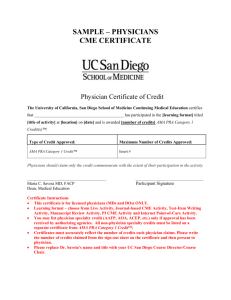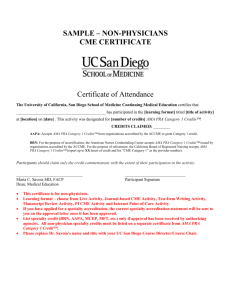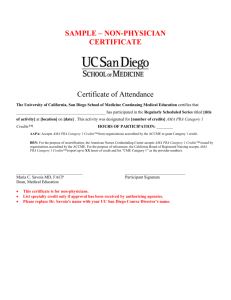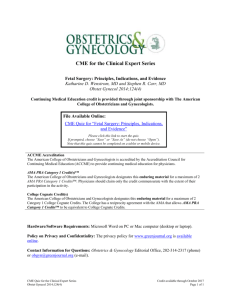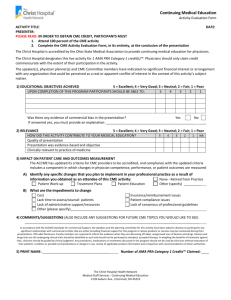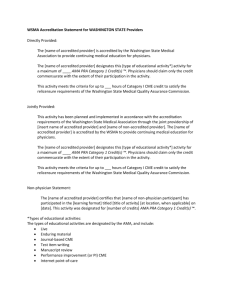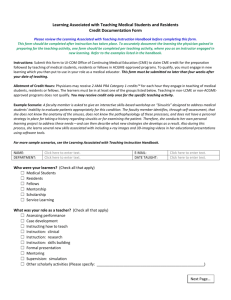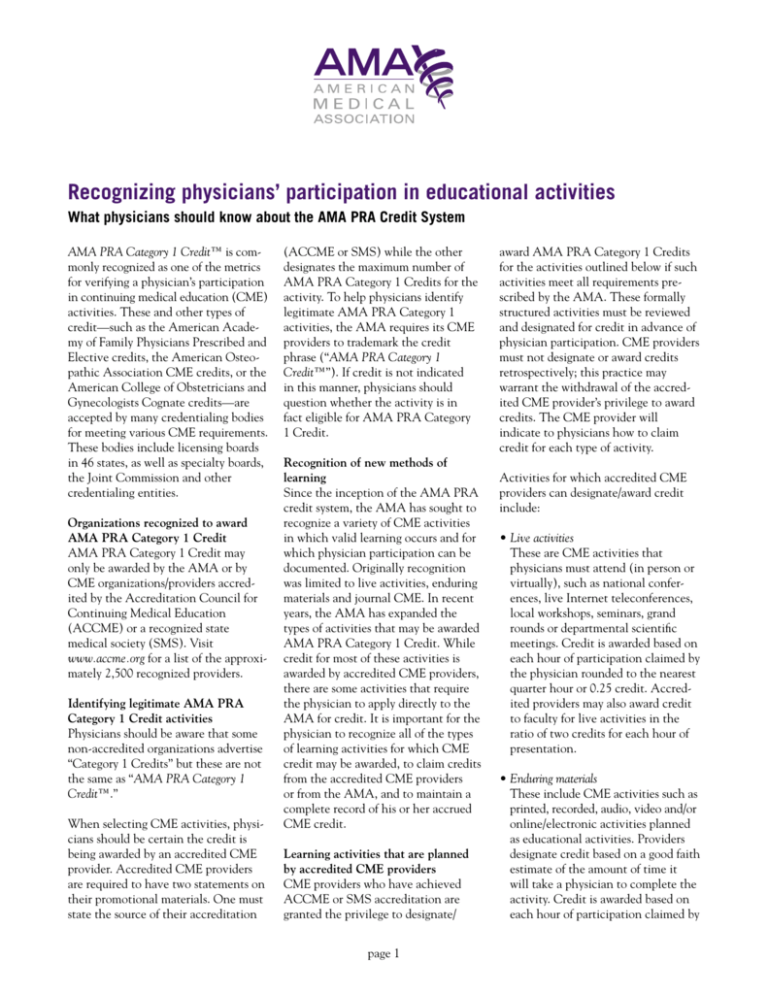
Recognizing physicians’ participation in educational activities
What physicians should know about the AMA PRA Credit System
AMA PRA Category 1 Credit™ is commonly recognized as one of the metrics
for verifying a physician’s participation
in continuing medical education (CME)
activities. These and other types of
credit—such as the American Academy of Family Physicians Prescribed and
Elective credits, the American Osteopathic Association CME credits, or the
American College of Obstetricians and
Gynecologists Cognate credits—are
accepted by many credentialing bodies
for meeting various CME requirements.
These bodies include licensing boards
in 46 states, as well as specialty boards,
the Joint Commission and other
credentialing entities.
Organizations recognized to award
AMA PRA Category 1 Credit
AMA PRA Category 1 Credit may
only be awarded by the AMA or by
CME organizations/providers accredited by the Accreditation Council for
Continuing Medical Education
(ACCME) or a recognized state
medical society (SMS). Visit
www.accme.org for a list of the approximately 2,500 recognized providers.
Identifying legitimate AMA PRA
Category 1 Credit activities
Physicians should be aware that some
non-accredited organizations advertise
“Category 1 Credits” but these are not
the same as “AMA PRA Category 1
Credit™.”
When selecting CME activities, physicians should be certain the credit is
being awarded by an accredited CME
provider. Accredited CME providers
are required to have two statements on
their promotional materials. One must
state the source of their accreditation
(ACCME or SMS) while the other
designates the maximum number of
AMA PRA Category 1 Credits for the
activity. To help physicians identify
legitimate AMA PRA Category 1
activities, the AMA requires its CME
providers to trademark the credit
phrase (“AMA PRA Category 1
Credit™”). If credit is not indicated
in this manner, physicians should
question whether the activity is in
fact eligible for AMA PRA Category
1 Credit.
Recognition of new methods of
learning
Since the inception of the AMA PRA
credit system, the AMA has sought to
recognize a variety of CME activities
in which valid learning occurs and for
which physician participation can be
documented. Originally recognition
was limited to live activities, enduring
materials and journal CME. In recent
years, the AMA has expanded the
types of activities that may be awarded
AMA PRA Category 1 Credit. While
credit for most of these activities is
awarded by accredited CME providers,
there are some activities that require
the physician to apply directly to the
AMA for credit. It is important for the
physician to recognize all of the types
of learning activities for which CME
credit may be awarded, to claim credits
from the accredited CME providers
or from the AMA, and to maintain a
complete record of his or her accrued
CME credit.
Learning activities that are planned
by accredited CME providers
CME providers who have achieved
ACCME or SMS accreditation are
granted the privilege to designate/
page award AMA PRA Category 1 Credits
for the activities outlined below if such
activities meet all requirements prescribed by the AMA. These formally
structured activities must be reviewed
and designated for credit in advance of
physician participation. CME providers
must not designate or award credits
retrospectively; this practice may
warrant the withdrawal of the accredited CME provider’s privilege to award
credits. The CME provider will
indicate to physicians how to claim
credit for each type of activity.
Activities for which accredited CME
providers can designate/award credit
include:
• Live activities
These are CME activities that
physicians must attend (in person or
virtually), such as national conferences, live Internet teleconferences,
local workshops, seminars, grand
rounds or departmental scientific
meetings. Credit is awarded based on
each hour of participation claimed by
the physician rounded to the nearest
quarter hour or 0.25 credit. Accredited providers may also award credit
to faculty for live activities in the
ratio of two credits for each hour of
presentation.
• Enduring materials
These include CME activities such as
printed, recorded, audio, video and/or
online/electronic activities planned
as educational activities. Providers
designate credit based on a good faith
estimate of the amount of time it
will take a physician to complete the
activity. Credit is awarded based on
each hour of participation claimed by
the physician rounded to the nearest
quarter hour or 0.25 credit.
• Journal-based CME learning
These represent CME activities
within a peer-reviewed, professional
journal designated for credit by an
accredited CME provider (e.g., the
Journal of the American Medical
Association). A maximum of one
credit is awarded for completion of
each designated article.
• Test item writing
Another CME activity includes
researching, drafting and defending
potential questions for examinations given by the National Board
of Medical Examiners or a member
board of the American Board of
Medical Specialties (ABMS®), or for
peer-reviewed, published self-assessment educational activities from a
national medical specialty society.
A physician may be awarded a maximum of 10 credits for completion of
each test item writing activity.
• Manuscript review (for journals)
This includes CME activities in
which journal manuscripts indexed
by MEDLINE® are critically reviewed
under the direction of an editor working with an accredited CME provider.
A physician may be awarded a maximum of three credits for completion
of each manuscript review.
• Performance improvement (PI) learning
These are CME activities involving
a structured, three-stage process by
which a physician or group of physicians can: (1) learn about specific
performance measures and retrospectively assess their practice; (2)
implement interventions to improve
their outcomes; and (3) re-evaluate
their performance. With PI CME, a
physician may be awarded five credits
for completion of each of the three
stages of PI CME that he or she is
actively engaged in, with an additional five credits being awarded if a
physician completes all three stages
in sequence. The PI CME learning model integrates performance
improvement interventions as part of
an educational activity.
The PI model of CME recasts the
important role that CME can play in
changing/measuring physician performance. It is anticipated that participation
in PI CME activities as planned by
accredited CME providers will be recognized by specialty boards as meeting the
requirements for Part IV of Maintenance of Certification Performance in
Practice. PI CME may also be accepted
as meeting other requirements for
performance data, such as Centers for
Medicare & Medicaid Services
pay for performance and eventually
maintenance of licensure. Physicians
can advance the development of PI
CME by working with accredited CME
providers to encourage the development
of these activities.
• Internet point of care learning (PoC)
This form of CME activity represents
structured, self-directed online learning by physicians on topics relevant
to their clinical practice. Learning
for this activity is driven by a reflective process in which a physician
must document his or her clinical
question, the sources consulted and
the application to practice. A physician may be awarded 0.5 credits
for completion of the three-step
learning cycle.
• Other activities
Additional structured activities, such
as committee learning or learning
plans/contracts, that are developed
in accordance with all appropriate
AMA PRA rules may be designated
for CME credit.
Learning activities recognized directly
by the AMA
Certain activities have been recognized
by the AMA as valuable learning
experiences that are not formally
sponsored by an accredited CME
provider. The AMA will directly award
credit for these activities when all
required documentation is submitted.
ACCME-/SMS-accredited CME
providers may not award credits for
these activities; credit may only be
awarded by applying directly to the
AMA (www.ama-assn.org/go/cme).
Other educational activities recognized
by the AMA for CME credit include:
page • F aculty may claim two AMA PRA
Category 1 Credits for each hour
they present at a live activity designated for such credit. Credit may be
claimed in 15 minute or 0.25 credit
increments.
• Publishing articles (publishing, as a
lead author, an article in a journal
included in the MEDLINE bibliographic database; 10 AMA PRA
Category 1 Credits per article)
• Poster presentations (preparing a
poster presentation, which is also
included in the published abstract,
for a conference designated for AMA
PRA Category 1 Credit; five AMA
PRA Category 1 Credits per poster
presentation)
• Medically related advanced degrees
(25 AMA PRA Category 1 Credits)
• ABMS® member-board certification,
recertification and/or maintenance
of certification (recognizes the educational effort associated with successfully completing an ABMS board
certification process; 25 AMA PRA
Category 1 Credits)
• Accreditation Council for Graduate
Medical Education (ACGME)–
accredited education (recognizes
the educational effort associated
with successful participation in an
ACGME-accredited residency or
fellowship program; 20 AMA PRA
Category 1 Credits per year)
• Independent learning (credit varies
depending on the details of the
approved project)
Claiming AMA PRA Category 1
Credit and maintaining CME records
It is important for physicians to recognize their ethical responsibility to only
claim CME credits commensurate with
their actual participation in any CME
activity. Accredited CME providers are
expected to award AMA PRA Category
1 Credits based on the amount of credit
claimed by the individual physician
rather than awarding the maximum
amount of credit designated for the
activity. This is why CME providers
ask physicians how many credits are
being claimed before issuing certificates
or transcripts. Physicians should claim
credit immediately upon completion of
the activity.
There is currently no central repository for collecting and maintaining a
record of a physician’s CME credits.
Some hospitals and medical societies
do provide tracking services for physician members, but because physicians
obtain CME from many sources, these
systems depend on physician selfreporting to be complete. Ultimately
each physician must be responsible for
maintaining his or her own records of
participation in CME.
AMA PRA Category 2 Credit
The AMA recognizes that there are
other educational experiences that
may not be developed by an accredited CME provider or may not qualify
for direct credits, but that do provide
valuable learning for the physician.
Examples of such activities include:
•T
eaching residents, medical students
or other health professionals
• Unstructured online searching and
learning (i.e., not Internet PoC)
• Reading authoritative medical
literature
• Consultation with peers and medical
experts
• Group discussions
• Self-assessment activities
• Medical writing
• Preceptorships
• Research
• Participating in live activities not
designated for AMA PRA Category
1 Credit
Participation in an activity listed above
may be claimed by the physician for
AMA PRA Category 2 Credit™ if all
three of the following are true:
1) The activity complies with the
AMA definition of CME.
2) The activity complies with the
AMA ethical opinions on gifts to
physicians from industry and ethical
issues in CME (i.e., is not promotional).
3) The activity is determined by the
physician to be a worthwhile learning experience related to his or her
practice.
• It is physicians’ ethical responsibility
to claim credit only commensurate
with their participation in the
activity.
Accredited CME providers may not
designate activities for AMA PRA
Category 2 Credit. These must be
claimed and documented by the physician learner.
• Physicians must maintain their own
records of CME credits earned.
Recording AMA PRA Category 2
Credit activities is important, as these
credits may count toward meeting the
requirements for the AMA PRA, as
well as for licensing and other credentialing requirements. When claiming
AMA PRA Category 2 Credits, physicians should calculate the number of
credits based on the number of hours
of participation rounded to the nearest
quarter hour (e.g., 85 minutes of participation amounts to 1.5 AMA PRA
Category 2 Credits).
Summary
To receive AMA PRA Category 1 and
AMA PRA Category 2 Credits, it is
important for physicians to recognize
that:
• AMA PRA Category 1 Credit is the
most common metric for verifying
participation in CME.
• AMA PRA Category 1 Credit can be
awarded only by ACCME- or SMSaccredited CME providers or by the
AMA itself.
• Legitimate AMA PRA Category 1
activities can be identified by use of
the trademarked term “AMA PRA
Category 1 Credit™.”
• Accredited CME providers may
designate (in advance) AMA PRA
Category 1 Credit for a variety of
formally planned learning activities,
but no activities may be designated
for credit retrospectively.
• Physicians may claim AMA PRA
Category 1 Credit directly from the
AMA for specific learning experiences that can be documented and
that are not formally sponsored by an
accredited CME provider.
page • AMA PRA Category 2 Credits may
be used to meet the requirements
for both AMA PRA and for other
credentialing purposes.
There are three easy ways to get
additional information about AMA PRA
credit and the AMA Physician’s
Recognition Award.
Visit www.ama-assn.org/go/pra
E-mail pra@ama-assn.org
Call (312) 464-4672
Copyright 2007 American Medical
Association. All rights reserved.
Permission is granted to any
individual or entity to copy
and distribute this material as
long as the copyright statement
is included, the contents are not
changed, and the copies are not
sold or licensed or included in any
publication that is sold or licensed.
Any use of this material to imply
AMA approval or endorsement of any
program is specifically prohibited.


